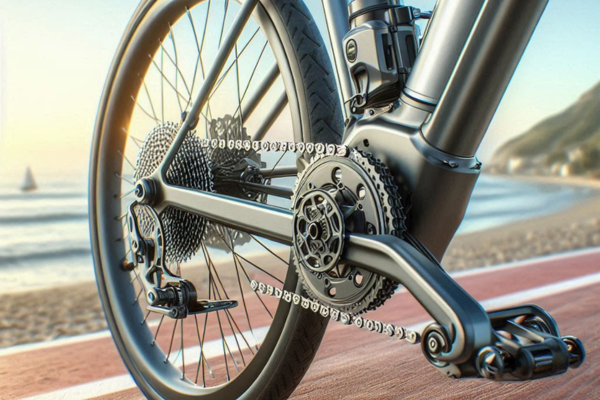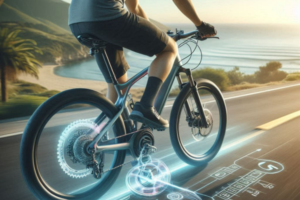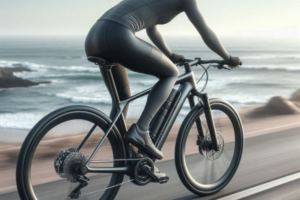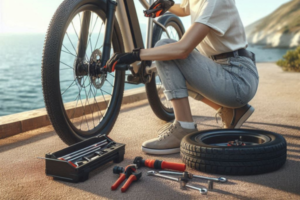⚙️ Understanding Gear Ratios: The Key to E-Bike Performance
When it comes to enhancing your e-bike’s performance, many riders focus on battery capacity, motor power, or tire pressure. However, there’s a fundamental yet often overlooked factor that significantly influences your ride: gear ratios. Understanding how gear ratios work can help you ride more efficiently, extend battery life, and achieve higher speeds with less effort.
🔍 What Is a Gear Ratio?
A gear ratio is the relationship between the number of teeth on your front chainring (connected to the pedals) and the number of teeth on your rear cog (connected to the wheel). This ratio determines how many times the rear wheel turns with each pedal stroke. For example, a 44-tooth front chainring paired with a 22-tooth rear cog results in a 2:1 gear ratio, meaning the rear wheel turns twice for every full pedal rotation.
Higher gear ratios (larger front chainring, smaller rear cog) allow for greater speed but require more effort to pedal. Conversely, lower gear ratios (smaller front chainring, larger rear cog) provide more torque, making it easier to pedal, especially when climbing hills or starting from a stop.
⚡ Why Gear Ratios Matter in E-Bikes
E-bikes combine human power with electric assistance, and gear ratios play a crucial role in optimizing this synergy. Proper gear selection ensures that both you and the motor operate efficiently, reducing strain and conserving battery life. For instance, using a lower gear when climbing allows the motor to assist more effectively without overexertion, while higher gears on flat terrain enable faster speeds with less pedaling effort.
Understanding and utilizing appropriate gear ratios can lead to:
- 🚀 Improved acceleration and top speed
- 🔋 Enhanced battery efficiency and range
- 🛠️ Reduced wear on drivetrain components
- 🎯 Better control and handling in various terrains
🌐 Adapting to Coastal Environments
In coastal areas, riders often face unique challenges such as strong winds, sandy paths, and varying elevations. Selecting the right gear ratio becomes even more critical in these conditions. Lower gears can help navigate headwinds and inclines, while higher gears are beneficial when riding with tailwinds or on flat, open roads.
💡 Tip: Regularly practicing gear shifts in different conditions can help you become more intuitive in selecting the optimal gear ratio, enhancing your overall riding experience.
🚴♀️ How Gear Ratios Influence Speed and Efficiency
Gear ratios are not just a mechanical detail—they are a critical factor in how your e-bike translates power into movement. Whether you’re commuting on city streets, riding coastal paths, or tackling challenging terrain, the gear ratio you use determines how efficiently you move, how much energy you expend, and how well your motor assists you.
📈 High Gear Ratios: Built for Speed
A high gear ratio means that the front chainring has significantly more teeth than the rear cog. For example, a 52-tooth chainring combined with an 11-tooth cog creates a high gear ratio (4.73:1). This setup is ideal for:
- 🚴♂️ Riding on flat or slightly downhill terrain
- 🌬️ Maximizing momentum during tailwinds
- ⚡ Maintaining high speeds with moderate pedaling effort
However, high gears require more initial effort to turn, making them less practical for starting from a stop or climbing hills. For e-bike riders, this means relying more on the motor for acceleration in high gear, which can lead to faster battery drain if used carelessly.
🌀 Low Gear Ratios: Made for Control and Climbing
A low gear ratio, such as a 34-tooth front and a 32-tooth rear cog (1.06:1), offers more torque and is easier on your legs and your motor. These gears are ideal when:
- 🧗♂️ Climbing hills or steep inclines
- 🚦 Starting from a full stop or in traffic
- 🌪️ Facing strong headwinds or sandy surfaces
For coastal riders, this low-gear advantage becomes especially important when dealing with shifting surfaces or gusty winds. Lower gears allow you to maintain cadence and control without overloading your motor or knees.
📊 Comparison Table: High vs. Low Gear Ratios
| Gear Ratio Type | Ideal Terrain | Benefits | Considerations |
|---|---|---|---|
| High (e.g., 52:11) | Flat, downhill, tailwind | High speed, low cadence | Harder start, higher battery use |
| Low (e.g., 34:32) | Hilly, windy, stop-and-go | More torque, easier on legs | Lower top speed |
🔁 The Importance of Smooth Shifting
Using the right gear at the right time is more than convenience—it’s a way to preserve your e-bike. Sudden shifts under pressure or staying in the wrong gear too long can wear out chains, sprockets, and strain the motor. Learning when and how to shift smoothly keeps your ride responsive and quiet.
💡 Tip: Practice shifting before hills, not during. Anticipating terrain changes improves efficiency and reduces stress on your drivetrain.
🔧 Types of Gear Systems and How They Shape Your Ride
Understanding gear ratios is only part of the equation. The type of gearing system your e-bike uses directly impacts how you interact with those ratios. Whether you’re navigating hilly terrain, riding coastal roads, or commuting through urban environments, choosing the right transmission system can greatly influence your ride quality, maintenance needs, and long-term performance.
🚲 Derailleur Systems: Lightweight and Versatile
The most common gear system found on traditional bikes and many e-bikes is the derailleur. It uses a series of external cogs and a chain that physically shifts between gears. Derailleur systems offer a wide gear range, which makes them ideal for riders who need flexibility across varying terrains.
- ✅ Lightweight and efficient
- ✅ Wide gear range for different inclines
- ❌ Requires regular cleaning and adjustment
- ❌ More exposed to sand, water, and corrosion—especially in coastal zones
⚙️ Internal Hub Gears: Simplicity and Protection
Hub gears are enclosed systems located in the rear wheel hub. They allow riders to shift gears while stationary and are highly resistant to dirt and water. This makes them particularly appealing for e-bike commuters or riders in environments with unpredictable weather or exposure to salt air.
- ✅ Low maintenance and weather-resistant
- ✅ Great for stop-and-go traffic or casual riding
- ❌ Heavier than derailleur setups
- ❌ Less gear range, not ideal for steep climbs or racing
🔁 Continuously Variable Transmission (CVT): Smooth but Costly
Some premium e-bikes are equipped with a continuously variable transmission (CVT), such as the Enviolo hub. Instead of shifting between set gear steps, CVT systems allow you to dial in the exact resistance you want. It’s a seamless, intuitive experience—especially valuable in city and coastal environments where speed and wind resistance fluctuate frequently.
- ✅ No gear steps—completely smooth transitions
- ✅ Excellent for riders focused on comfort and ease of use
- ❌ More expensive and heavier than other systems
- ❌ Repairs require specialized service
📊 Comparison Table: Gear Systems at a Glance
| System Type | Ideal Use | Pros | Cons |
|---|---|---|---|
| Derailleur | Performance, sport, hills | Light, wide range | Needs frequent cleaning |
| Internal Hub | Urban, all-weather | Low maintenance | Limited gear range |
| CVT | Commuting, comfort | Seamless shifting | Heavy, expensive |
🌊 Best Option for Coastal Riders?
In coastal cities, internal hub or CVT systems offer significant advantages thanks to their sealed design. These gear systems protect sensitive components from salt, humidity, and sand—making them perfect for riders who prioritize reliability and ease of maintenance over ultra-performance.
💡 Insight: The best gear system isn’t the most advanced—it’s the one that aligns with your environment and riding goals.
🧰 Monthly Gear System Maintenance for Smooth and Efficient Rides
Just like your motor and battery, the gear system on your e-bike requires attention and care to function properly. Whether you ride daily in coastal areas or on dry urban roads, monthly maintenance ensures that gear shifts stay smooth, components last longer, and your e-bike remains fast and responsive. Lightweight doesn’t mean low-maintenance—it means focused attention where it counts.
📅 Monthly Inspection Routine: Derailleur Systems
If your e-bike uses a derailleur system, regular cleaning and alignment are essential to avoid shifting problems or excessive wear. Exposure to sand, water, and grime—common in coastal regions—can corrode metal components and cause chain skipping or gear lag.
- 🔍 Check derailleur alignment: Inspect hanger and derailleur arm for bends; misalignment can cause poor shifting.
- 🧽 Clean chain and cassette: Use a degreaser and brush to remove dirt and apply dry or wet lube based on the climate.
- 🔧 Test cable tension: Pull gear levers through the full range and adjust barrel tension if shifting feels sluggish.
🛡️ Monthly Care for Internal Hub Gears
Internal hub gears are low-maintenance but not maintenance-free. Coastal riders in particular should watch for salt corrosion around the hub and cable entry points.
- 🧴 Wipe the hub casing clean: Use a soft cloth to remove buildup of salt or dirt near the seals.
- 🔩 Inspect shifter cable tension: Adjust if shifting becomes stiff or inconsistent.
- 🛠️ Hub oil change (annually or per brand): Follow manufacturer guidelines—often needed every 3,000 to 5,000 km.
🔁 CVT System Maintenance: Smooth Doesn’t Mean Neglect
CVT systems like Enviolo require less user involvement but still benefit from regular inspection. The sealed housing is great against salt, but maintenance should focus on calibration and keeping tension systems free of debris.
- 📦 Visually inspect casing and cables monthly for cracks or damage from UV or debris.
- 🧪 Lubricate pivot points or tensioning systems as recommended by the manufacturer.
- 🧰 Schedule professional service: Once a year or if you hear grinding or slipping while riding.
📊 Maintenance Checklist: Monthly at a Glance
| System | Key Task | Why It Matters |
|---|---|---|
| Derailleur | Chain cleaning + gear calibration | Smooth shifting, avoid chain wear |
| Hub Gear | Wipe seals, check tension | Prevent internal damage and corrosion |
| CVT | Inspect casing, lubricate moving parts | Avoid slippage or sensor misreadings |
🧠 Pro Tip for Coastal Riders
Keep a microfiber cloth and silicone protectant spray in your toolkit. Wipe down gears, cables, and connectors after each ride near the ocean. This small habit can prevent salt damage and keep your system performing like new.
💡 Reflection: A quiet, smooth-shifting e-bike is a sign of care. Your gear system is your bike’s voice—listen to it monthly.
💬 Frequently Asked Questions (FAQs)
Do gear ratios really make a difference on e-bikes?
Absolutely. While the motor provides assistance, your e-bike still relies on mechanical input. Gear ratios allow you to match your pedal effort with the terrain, improving speed, efficiency, and battery usage. Using the right gear keeps both your legs and the motor running smoothly.
What gear ratio should I use for maximum speed?
Higher gear ratios (e.g., 52:11) are ideal for maintaining top speeds on flat terrain or with tailwinds. However, using them too early or on inclines can overwork your motor. Combine them with a steady cadence for the best results.
How often should I clean or adjust my gearing system?
Monthly inspection is a great baseline. In coastal or humid climates, consider bi-weekly cleaning, especially for derailleur systems. Hub gears and CVT setups require less frequent attention but benefit from seasonal adjustments or annual oil changes.
Which is better: internal hub or derailleur?
It depends on your priorities. Derailleurs offer more gears and better climbing power. Internal hubs are cleaner, more reliable in bad weather, and perfect for urban or coastal riders who value low maintenance and simplicity.
Can changing my gear ratio extend battery life?
Yes. Riding in the appropriate gear reduces strain on the motor, meaning it doesn’t have to work as hard. This not only extends your range but also reduces long-term wear on your motor and drivetrain.
💖 Final Thoughts: Gear Up, Ride Smart
E-bikes are a beautiful blend of technology and human power—and gear ratios are where those two forces meet. Mastering your gears is about more than mechanics; it’s about feeling connected to your ride, anticipating the road ahead, and optimizing every pedal stroke.
Whether you’re gliding through coastal winds, climbing city hills, or commuting to work, the right gear system transforms your ride. It saves energy, protects your components, and boosts your confidence. In short, it helps you ride smarter—not just faster.
💡 Inspiration: A well-chosen gear isn’t just a setting—it’s a decision that turns effort into elegance.
🌍 Join the Conversation: What Gear Setup Works Best for You?
Now it’s your turn. What type of gear system does your e-bike use? Have you had better results with internal hubs, derailleurs, or even CVT systems? What gear ratios give you the smoothest, fastest, or most reliable ride in your environment?
We’d love to hear your insights:
⚙️ How do you adjust your gears for hilly vs. coastal rides?
🔧 Any maintenance hacks for keeping your gears in top condition?
💬 Which setup helped you get the most from your e-bike?
Drop your stories, tips, and questions in the comments below. Let’s build a knowledge-sharing space for riders who want to ride smarter, preserve their bikes longer, and enjoy every pedal stroke with purpose. 🚴♀️✨🌬️



